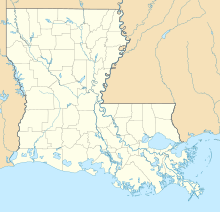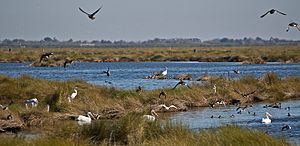Bayou Sauvage National Wildlife Refuge facts for kids
Quick facts for kids Bayou Sauvage National Wildlife Refuge |
|
|---|---|
|
IUCN Category IV (Habitat/Species Management Area)
|
|
| Nearest city | New Orleans, Louisiana |
| Area | 22,770 acres (92.1 km2) |
| Established | 1990 |
| Governing body | U.S. Fish and Wildlife Service |
| Website | Bayou Sauvage National Wildlife Refuge |
The Bayou Sauvage National Wildlife Refuge is a huge natural area right inside New Orleans, Louisiana. It covers about 23,000 acres (93 square kilometers) of fresh and salty marshes. This makes it the biggest wildlife refuge in a city across the entire United States!
Where is Bayou Sauvage?
The Bayou Sauvage Refuge is located in the eastern part of New Orleans. Much of this special area is protected by huge walls called levees. These levees help keep the city safe from strong storm surges during hurricanes.
For many years, this land was planned to become a giant community. It had different names like "Pontchartrain" or "New Orleans East." To prepare for this, three exits were built on I-10. But the community was never built. So, two of these exits were never used. Today, drivers sometimes call them "ghost exits."
Amazing Wildlife
The refuge is home to many different animals. From May to July, you can find a huge nesting area for wading birds in the swamps. In the colder months, tens of thousands of waterfowl spend the winter in the marshes.
The brown pelican lives in southeast Louisiana all year. More and more brown pelicans are nesting here, even though some of their nesting spots have been lost. These pelicans often visit the refuge. You might also see several bald eagles, which are another special bird species.
Other animals you can find include many types of waterfowl, wading birds, and shorebirds. There are also marsh rabbits, white pelicans, and alligators. You can also spot other birds of prey, small mammals, reptiles, and amphibians.
Different Habitats
The refuge has many different kinds of natural areas, called habitats. These include:
- Fresh and brackish (slightly salty) marshes
- Bottomland hardwood forests (forests in low-lying areas)
- Lagoons (shallow bodies of water)
- Canals and borrow pits (human-made water channels)
- Chenieres (old beach ridges)
- Natural bayous (slow-moving streams)
The marshes near Lake Pontchartrain and Lake Borgne are like nurseries for young fish, crabs, and shrimp. The freshwater lagoons, bayous, and ponds are great places for fish like largemouth bass, crappie, bluegill, and catfish.
These different habitats help 340 different kinds of birds throughout the year. During fall, winter, and early spring, as many as 75,000 waterfowl use the wetland areas.



